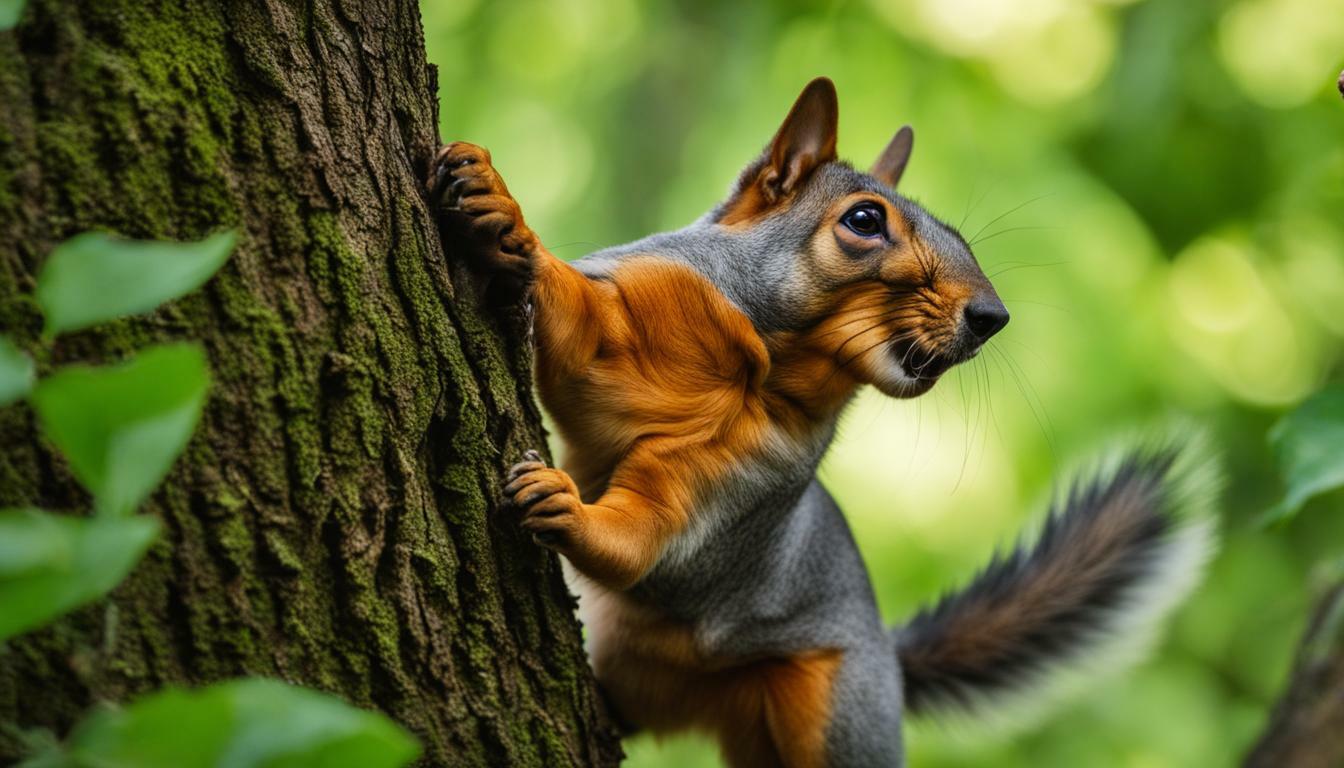Have you ever wondered if squirrels taunt dogs? Let’s delve into the fascinating world of animal behavior and find out!
Key Takeaways:
- Squirrels taunt dogs for fun, to defend their territory, and to escape.
- Squirrels view dogs as a new “toy” to play with due to their natural curiosity.
- Squirrels may throw things or make noise to taunt dogs when chased.
- They tease dogs to protect their territory and ensure their own safety.
- Dogs may sustain minor injuries while chasing squirrels, and squirrels can carry diseases that can harm dogs.
Understanding Squirrel Behavior
Before we dive into squirrel-dog interactions, let’s explore the intriguing behavior of squirrels. These furry creatures are known for their playful antics and curious nature, making them a delight to observe in any backyard or park. Squirrels are intelligent and adaptive, often displaying remarkable agility as they navigate trees and leap from branch to branch.
One of the key aspects of squirrel behavior is their propensity for playfulness. Squirrels view the world as their playground and are constantly seeking new sources of amusement. Dogs, with their energy and enthusiasm, often become the unwitting recipients of their playful antics. For squirrels, dogs are like living toys, inviting them to engage in games of chase and mock confrontations.
Aside from their playful nature, squirrels also exhibit a strong instinct to protect their territory. When confronted by dogs, squirrels may taunt them as a means of defense. By provoking dogs through their actions, such as making noise or throwing things, squirrels aim to establish boundaries and maintain control over their environment. This territorial behavior ensures the safety of squirrels by keeping potential threats at a distance.
| Squirrel Behavior | Key Characteristics |
|---|---|
| Playfulness | Squirrels enjoy engaging in games and playful interactions with other animals, including dogs. |
| Territorial Instinct | Squirrels taunt dogs as a means of defending their territory and establishing boundaries. |
| Curiosity | Squirrels are naturally curious creatures, always exploring their surroundings and seeking new experiences. |
While chasing squirrels may seem like harmless fun for dogs, it’s important to note that it can lead to potential risks. Squirrels can carry diseases that can be harmful to dogs, and dogs can sustain injuries while trying to reach squirrels high up in trees. To ensure the safety of both dogs and squirrels, it is advisable to deter dogs from chasing squirrels by offering alternative toys, keeping them on a leash, or providing a secure fence to separate them. Responsible pet ownership is crucial to maintaining harmonious squirrel-dog interactions and protecting the well-being of both animals.
Squirrels as Playful Provocateurs
Squirrels, mischievous creatures that they are, often find pleasure in taunting dogs. With their natural curiosity and playful nature, squirrels view dogs as their new “toy” to play with. It’s not uncommon to see a squirrel perched on a tree branch, chattering at a bewildered dog below. But why do squirrels taunt dogs in the first place?
One reason is defense. Squirrels are territorial animals, and when they spot a dog encroaching on their turf, they may taunt it to protect their territory. By teasing the dog from a safe distance, the squirrel ensures its own safety and keeps the dog at bay. In this way, taunting becomes a form of self-preservation for squirrels.
Squirrels Tease to Entertain and Escape
Moreover, squirrels taunt dogs simply because they find it entertaining. Chasing and evading a barking canine can be an exhilarating game for these nimble little creatures. They might tease the dog by making playful leaps from tree to tree or by scampering just out of reach, leaving the dog frustrated and bewildered. It’s all part of the squirrel’s mischievous nature.
But the taunting behavior also serves another purpose—to escape. When pursued by a dog, a squirrel will often resort to tricks like throwing things or making noise to divert the dog’s attention. By engaging the dog in a playful game instead of a chase, the squirrel increases its chances of getting away unscathed.
| Squirrel Behavior | Squirrel Taunting |
|---|---|
| Natural curiosity | Entertainment for squirrels |
| Playful nature | Defense mechanism for territory |
| Escaping from dogs | Diversionary tactics |
While chasing squirrels can be an enjoyable pastime for dogs, it’s important to remember the potential risks involved. Dogs may sustain minor injuries like sprains or cuts during the chase. Additionally, squirrels can carry diseases that can harm dogs, such as rabies or ticks. To protect both your furry friend and the neighborhood squirrels, it’s advisable to deter dogs from chasing them.
There are several ways to discourage dogs from chasing squirrels. Provide alternate toys to keep them engaged, keep dogs indoors or on a leash when in proximity to squirrels, or install a fence to create a physical barrier. By practicing responsible pet ownership, we can help ensure the safety and well-being of both dogs and squirrels.
Motives Behind Squirrel Taunting
What motivates squirrels to tease dogs? Let’s explore the possible reasons behind their behavior.
- Squirrels view dogs as a new source of entertainment. These furry creatures are naturally curious and see dogs as playmates. Chasing and taunting dogs becomes a game for them, adding excitement to their day.
- Defending their territory is another motive behind squirrel taunting. Squirrels are known to be territorial creatures and may view dogs as intruders. By teasing and taunting dogs, squirrels are trying to assert their dominance and protect their space.
- Squirrels also tease dogs to keep them at bay. They understand that dogs pose a potential threat and can cause harm. By taunting and frustrating dogs, squirrels hope to keep a safe distance and maintain their own security.
The Impact of Squirrel and Dog Interactions
The interactions between squirrels and dogs can have lasting effects on both animals and their environments.
- For dogs, chasing squirrels can be a thrilling activity. However, it is not without risks. Dogs may sustain minor injuries like sprains or cuts while attempting to catch squirrels. It is important to ensure their safety and provide proper training.
- On the other hand, squirrels can carry diseases that can harm dogs. It is essential to prevent close contact between squirrels and dogs to minimize the risk of disease transmission.
- In addition, squirrel and dog interactions can disrupt the natural balance of the ecosystem. Squirrels play a vital role in seed dispersal and are an important part of the food chain. Disturbing their behavior through constant chasing can have unintended consequences.
To protect both dogs and squirrels, responsible pet ownership is crucial. Deter dogs from chasing squirrels by offering alternate toys to keep them engaged. Keep dogs inside or on a leash when outside to prevent interactions. If possible, consider building a fence to separate squirrels from areas where dogs frequently play. These measures will help ensure the well-being of both animals and maintain harmony in their shared environment.
| Squirrel Taunting Motives | Impact of Interactions |
|---|---|
| Squirrels find it entertaining | Dogs may sustain minor injuries |
| Defending their territory | Squirrels can carry diseases |
| Keeping dogs at a safe distance | Squirrel and dog interactions disrupt the ecosystem |
Squirrels’ Tactics of Taunting
When faced with a chasing dog, squirrels have a few tricks up their sleeves to keep the dog at bay. These playful and mischievous critters are known for their ingenious tactics in taunting their pursuers. One common tactic is throwing things at the dog, such as acorns or small twigs. This not only startles the dog but also serves as a distraction, giving the squirrel an opportunity to make a quick getaway.
In addition to throwing objects, squirrels are masters of making noise. They possess a wide range of vocalizations, from screeches and chatters to barks and squeaks. When confronted by a dog, squirrels will often emit these sounds to confuse and frustrate their pursuer. This not only diverts the dog’s attention but also serves as a warning to other squirrels in the area, notifying them of potential danger.
Squirrels are agile climbers and skilled jumpers, and they leverage these abilities to their advantage when taunting dogs. They will often scamper up trees and traverse branches, always staying just out of reach of the dog. This not only frustrates the dog but also showcases the squirrel’s superior agility. It’s as if they are saying, “Try as you might, you can never catch me!”
| Tricks of Squirrel Taunting |
|---|
| Throwing objects (acorns, twigs) at the dog |
| Making various vocalizations to confuse and distract the dog |
| Utilizing their climbing and jumping abilities to stay out of reach |
Safety Measures for Dogs
While chasing squirrels can be a fun pastime for dogs, it’s important to ensure their safety during these encounters. Squirrels are known to taunt and provoke dogs, often leading to confrontations that can pose risks for both animals. To protect your furry friend, here are some safety measures you can take:
1. Provide alternative toys:
One way to deter dogs from chasing squirrels is to offer them alternative toys and activities that can keep them engaged. Interactive toys, puzzle games, and treat-dispensing toys can help redirect their attention and energy, preventing them from obsessively chasing squirrels.
2. Keep dogs on a leash:
When walking your dog in areas where squirrels are prevalent, it’s crucial to keep them on a leash. This not only ensures their safety but also prevents them from approaching squirrels and potentially getting into confrontations or causing harm to themselves.
3. Create a secure outdoor space:
If you have a yard where your dog can roam freely, consider building a secure fence to separate them from squirrels. This will help prevent any direct interactions and reduce the temptation for your dog to chase after the squirrels.
| Pros of Safety Measures | Cons of No Safety Measures |
|---|---|
| Protects dogs from potential injuries | Dogs may sustain minor injuries like sprains or cuts while chasing squirrels |
| Reduces the risk of dogs contracting diseases from squirrels | Squirrels can carry diseases that may harm dogs |
| Prevents dogs from engaging in territorial disputes with squirrels | Dogs may harm themselves or the squirrels while trying to reach them |
By implementing these safety measures, you can ensure your dog’s well-being and minimize the potential risks associated with squirrel and dog confrontations. Remember, it’s important to prioritize your pet’s safety while still allowing them to enjoy their natural instincts.
Dangers for Squirrels and Dogs
Interactions between squirrels and dogs can pose risks to both parties involved – the squirrel and the dog. While squirrels may taunt dogs for their own amusement, the consequences can be detrimental. When a dog chases a squirrel, it puts itself at risk of sustaining minor injuries such as sprains or cuts. Squirrels, on the other hand, may use various tactics like throwing things or making noise to provoke the dog, potentially leading to a confrontation.
In addition to physical harm, there are other dangers that both squirrels and dogs face when they come into contact. Squirrels can carry diseases such as leptospirosis, salmonellosis, or even fleas and ticks that can harm dogs. If a dog tries to reach or capture a squirrel, it may injure itself in the process, causing harm to its limbs or body. These injuries can range from minor scratches to more serious wounds.
To ensure the safety and well-being of both squirrels and dogs, it is important to take preventive measures. If you have a dog that likes to chase squirrels, consider offering alternate toys and activities to redirect its attention. Keeping your dog inside or on a leash during walks can also help prevent interactions with squirrels. If you have a yard where squirrels are present, building a fence can help keep them separate from your dog.
| Dangers for Squirrels | Dangers for Dogs |
|---|---|
|
|
By taking responsible pet ownership seriously, you can minimize the risks associated with squirrel and dog interactions. It is crucial to prioritize the safety and well-being of both animals, as well as the surrounding environment. Understanding the behavior and motivations of squirrels, and implementing preventive measures, can help create a harmonious coexistence between dogs and squirrels.
Responsible Pet Ownership
As pet owners, it’s our responsibility to ensure the safety and well-being of both our dogs and the wildlife around them. When it comes to dog and squirrel interactions, it’s important to take proactive steps to prevent any harm to either party.
Dogs naturally have a strong prey drive, and chasing squirrels can be a tempting and exciting activity for them. However, it’s essential to discourage this behavior to protect both the squirrels and your dog.
One way to deter dogs from chasing squirrels is to provide them with alternative toys and activities that can keep them engaged and entertained. Interactive toys, puzzle feeders, and games like hide-and-seek can redirect their focus and energy in a safe and enjoyable way.
Another effective measure is to keep your dog inside or on a leash when you’re outside, especially in areas where squirrels are abundant. This ensures that your dog remains under your control and prevents any accidental confrontations with squirrels. If you have a yard, consider building a fence to separate your dog from areas where squirrels frequent.
| Measures for Responsible Pet Ownership | Benefits |
|---|---|
| Offer alternative toys and activities | Redirects your dog’s focus and energy, prevents chasing |
| Keep your dog inside or on a leash | Ensures control and avoids accidental confrontations with squirrels |
| Build a fence to separate your dog from squirrels | Creates a physical barrier, reduces the likelihood of interactions |
By following these responsible pet ownership measures, we can create a harmonious coexistence between our dogs and squirrels, ensuring the safety and well-being of both. It’s important to remember that squirrels are an integral part of our ecosystem and play a vital role in maintaining a healthy balance in nature. Let’s do our part in preserving and protecting the wildlife around us.
The Impact of Squirrel and Dog Interactions
The interactions between squirrels and dogs extend beyond the immediate chase – they can have broader impacts. While it may seem like harmless fun, squirrel taunting can lead to unintended consequences for both animals and their environments. It is essential to understand these impacts to ensure the safety and well-being of dogs and squirrels alike.
For squirrels, constant taunting by dogs can be incredibly stressful. Being chased by a predator triggers their fight-or-flight response, leading to increased anxiety and adrenaline levels. This chronic stress can take a toll on their health and overall survival. Additionally, squirrels may abandon their nests or territories in an attempt to escape persistent dog encounters, disrupting their natural habitat and potentially exposing them to new dangers.
On the other hand, dogs can also be negatively affected by squirrel taunting. While some dogs may enjoy the thrill of the chase, it can result in injuries such as sprained limbs or cuts from sharp objects. Moreover, squirrels can carry diseases that can be transmitted to dogs through bites or scratches. These diseases can range from parasites like fleas and ticks to more serious conditions like rabies.
The Importance of Responsible Pet Ownership
Given the potential risks and impacts of squirrel and dog interactions, it is crucial for pet owners to take responsibility for their dogs’ behavior. Ensuring the safety of both animals involves implementing various measures. Providing dogs with alternative toys and engaging them in mentally stimulating activities can help redirect their attention away from squirrels. Keeping dogs on a leash or within a securely fenced area when outside can prevent them from chasing squirrels altogether.
In addition to these measures, it is essential to educate ourselves and others about squirrel behavior. Understanding that squirrels taunt dogs out of curiosity and for self-preservation can help us approach these interactions with empathy and caution. By doing so, we can create a harmonious environment where both animals can coexist without harm.
| Dangers for Squirrels | Dangers for Dogs |
|---|---|
| – Increased stress levels | – Potential injuries |
| – Abandonment of nests and territories | – Exposure to diseases |
| – Disruption of natural habitat | – Risk of parasites |
Conclusion
In conclusion, squirrels do indeed taunt dogs, driven by their natural curiosity and the need to defend their territory. These playful provokers enjoy teasing dogs for their own entertainment, viewing them as a new “toy” to play with. When chased, squirrels may taunt dogs by throwing things or making noise, ensuring their own safety by keeping them at a distance.
While chasing squirrels can be a safe hobby for dogs, minor injuries such as sprains or cuts may occur. However, it is not advisable to let dogs play with squirrels, as it can result in harm to both animals. Squirrels can carry diseases that can harm dogs, and dogs can injure themselves while trying to reach squirrels.
To protect both dogs and squirrels, responsible pet ownership is crucial. Owners can deter dogs from chasing squirrels by offering alternate toys, keeping them inside, keeping them on a leash, or building a fence to separate them from squirrels. By taking these safety measures, we can minimize the risks associated with squirrel and dog interactions.
Overall, understanding squirrel behavior and the motives behind their taunting can help us create a harmonious environment for both animals. By respecting their natural instincts and taking appropriate precautions, we can ensure the well-being of our furry friends while appreciating the wonders of nature.
FAQ
Do squirrels taunt dogs?
Yes, squirrels do taunt dogs for fun, to defend their territory, and to escape. They enjoy teasing dogs and find it entertaining.
Why do squirrels taunt dogs?
Squirrels taunt dogs to ensure their own safety by keeping them at a distance. They also tease dogs to protect their territory or to drive them away.
How do squirrels taunt dogs?
When chased, squirrels may throw things or make noise to taunt the dog. They view dogs as a new “toy” to play with and employ various tactics to tease them.
Is it safe for dogs to chase squirrels?
Chasing squirrels can be a safe hobby for dogs, although they may sustain minor injuries like sprains or cuts. However, it is not advisable to let dogs play with squirrels as it can result in harm to both animals.
What are the risks of squirrel and dog interactions?
Squirrels can carry diseases that can harm dogs, and dogs can injure themselves while trying to reach squirrels. It is important to take precautions to prevent these risks.
How can I deter my dog from chasing squirrels?
You can deter dogs from chasing squirrels by offering alternate toys, keeping them inside, keeping them on a leash, or building a fence to separate them from squirrels.




